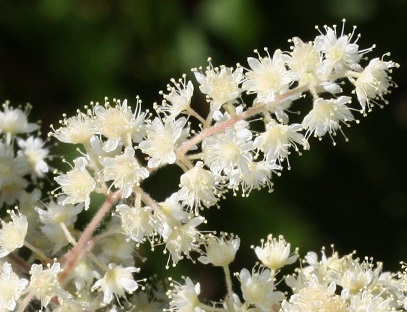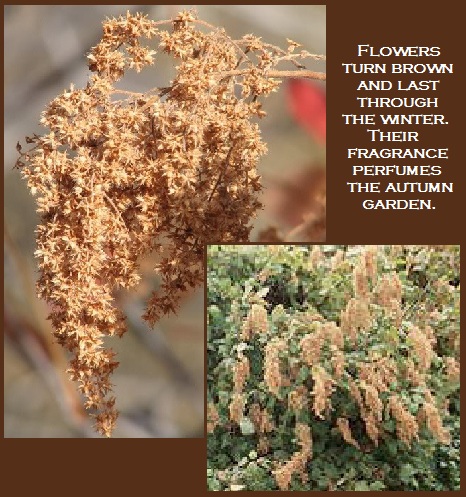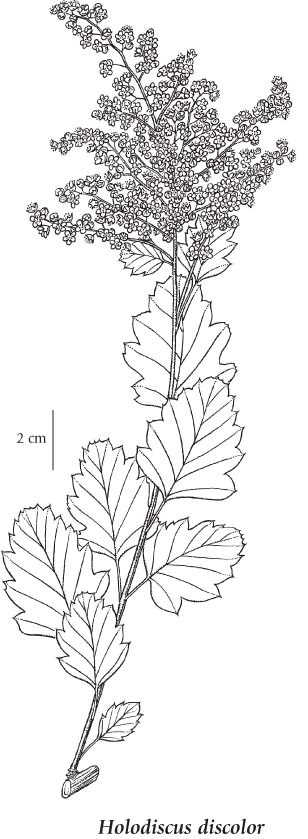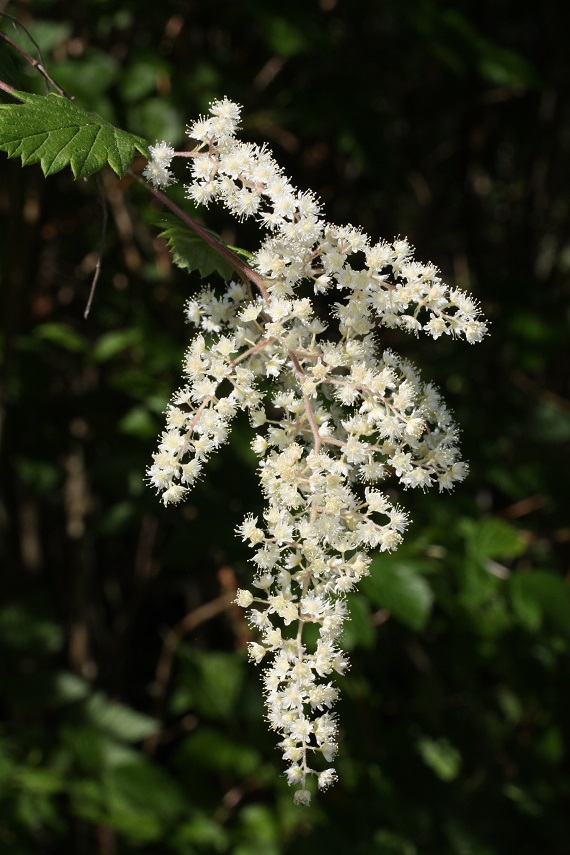|
|
|
Hansen's Northwest Native Plant Database |
|
Holodiscus discolor (Oceanspray, Creambush)
|
|
||||||||||||||||||||||||||||||
|
|||||||||||||||||||||||||||||||
|
Plant Brief: A beautiful deciduous shrub that grows to 20' in the wild - can be kept to 10' in the garden by pruning (the trimmings add character to bouquets). Pendants of creamy white flowers, whose fragrance improves with age, form in early summer and persist through fall and winter. This plant is sometimes referred to as "Ironwood," a reference to the incredible strength of the wood. Indeed the wood was carved into spikes and used as nails are now. Oceanspray prefers full sun and is found on dry, rocky slopes from southern BC to California and east to Montana (USDA zones 5-10). |
|||||||||||||||||||||||||||||||
|
|
Description: In early summer the Oceanspray bushes commence their display. The rocky slopes and forest edges in this area are host to these attractive shrubs. In flower it is easy to understand how they came upon their common name – the masses of tiny flowers are reminiscent of the mist from crashing waves. Oceanspray is the romance shrub of the Pacific Northwest – the flowers as fragile as summer love, mellowing with age but lingering through the seasons. The naming of "Oceanspray:" Imagine the wedding veil of a young maiden, forced to leave her true love and marry another. She flees her intended bridegroom and the wedding ceremony. As she scurries into the forest, she shreds her bridal veil and drapes it across the branches of shrubs so her true love can follow her path. Alas, he does not come for her but her veil clings to the bushes through the seasons as a lament to lost love. |
||||||||||||||||||||||||||||||
|
This showy shrub grows rapidly to reach heights of 3 – 15’ on the coast. It is significantly shorter in the interior, growing only 6 – 8’ tall. The arching branches develop in clumps rather than growing from a central stem. The leaves, lobed and triangular, are ¾” – 2 ½” long.The flowering habits of this plant are very distinct. First the flower buds form – dense, cream-colored clusters of tiny droplets. Then lacy masses of fragrant flowers bloom for many weeks between May and July. The seeds form from the brownish, dried flowers and persist throughout the autumn and well into the winter. Habitat and Range: Oceanspray is found growing in rocky, dry sites in partial to full sun. Its range extends from the south of British Columbia, east to Montana and south to California, in UDSA zones 5 – 10. It is generally found in areas that receive between 30” – 65” of rainfall annually. |
|||||||||||||||||||||||||||||||
|
Ornamental Value: Oceanspray is a highly decorative shrub, with its gracefully arched stems, its airy flower clusters and its remarkably long bloom time. Yet the display does not end with summer. Come autumn the dried flower clusters emit a sweet perfume and the foliage turns a delightful burgundy. Then into winter the dried flowers persist long after the foliage has fallen. Native Plant Gardening/Wildlife Habitat: The larvae of many native moths and butterflies feed on the foliage of this shrub. Oceanspray is also the home of choice for nesting bushtits. Because each cluster of flowers is made up of hundreds of tiny blooms, this plant produces a vast amount of pollen. It is therefore very useful in attracting pollinating insects. If you are a vegetable gardener or have fruit trees in your yard, consider planting several Oceanspray bushes to attract pollinators and ensure a bountiful harvest. Restoration and Mitigation Value: A shallow root system makes Oceanspray an ideal plant for areas with shallow topsoil, for rocky bluffs and to control erosion. It is also remarkably tolerant of both drought and poor soils. Finding plants for these “problem” areas, where plants are so crucial to prevent precious topsoil from eroding into creeks and rivers, is indeed a challenge and makes Oceanspray a natural treasure. Historical/Cultural uses: The alternative names for Oceanspray, Arrow–Wood and Ironwood, give us a hint of its former uses. The wood was exceptionally hard and strong and was invaluable to First Nations people. They used it to fashion arrows, harpoons, digging tools, sharp pins to anchor teepees and even awls for sewing and beadwork. Because the wood does not burn readily, it was also used to make cooking tools and spits for roasting salmon. |
|
||||||||||||||||||||||||||||||
|
Edible and Medicinal Uses:
Although some claim that the flowers of Oceanspray are edible, this is not
widely remarked and it is not at all advisable to eat any part of this
plant. As a medicine, Oceanspray does not appear to have been used
extensively by First Nations people, although the Saanich of Vancouver
Island, British Columbia made an infusion of the flowers to treat diarrhea
[RBCM]. Propagation Techniques: This shrub is easily started from seed collected in the fall. It germinates best when the growing medium contains a large proportion of sand to ensure proper drainage. Allow the seedlings a full season of growth before attempting to move them. Cuttings are very difficult to root and are best left to the experts. One can, however, attempt layering the branches in the spring. This method is often successful. Plant Associations: Oceanspray is often found on rocky ledges along with Stonecrop (Sedum), Common Camas (Camassia quamash) and Arbutus (Arbutus menziesii). No garden architect could perfect upon the harmony of that combination with its compliments of orange, purple, yellow and white! The low-growing Stonecrop hugs the rock face, the Camas makes a dazzling but brief appearance in spring while the Arbutus stretches upward with its vibrant limbs and glossy leaves – all of them softly accented by the graceful branches and delicate flowers of the Oceanspray. |
|||||||||||||||||||||||||||||||



,%20Bugwood.org_1214022sm.jpg)
 Photo, left, credit: Walter Siegmund; 4th Photo credit: Dave Powell, USDA Forest Service (retired), Bugwood.org; Last photo credit: Walter Siegmund |
|||||||||||||||||||||||||||||||
|
Photos We Share!
|
||||||||||||||||||||||||||||||
|
Bibliography: Thank you to the
following references for their invaluable information:
|
|
||||||||||||||||||||||||||||||
|